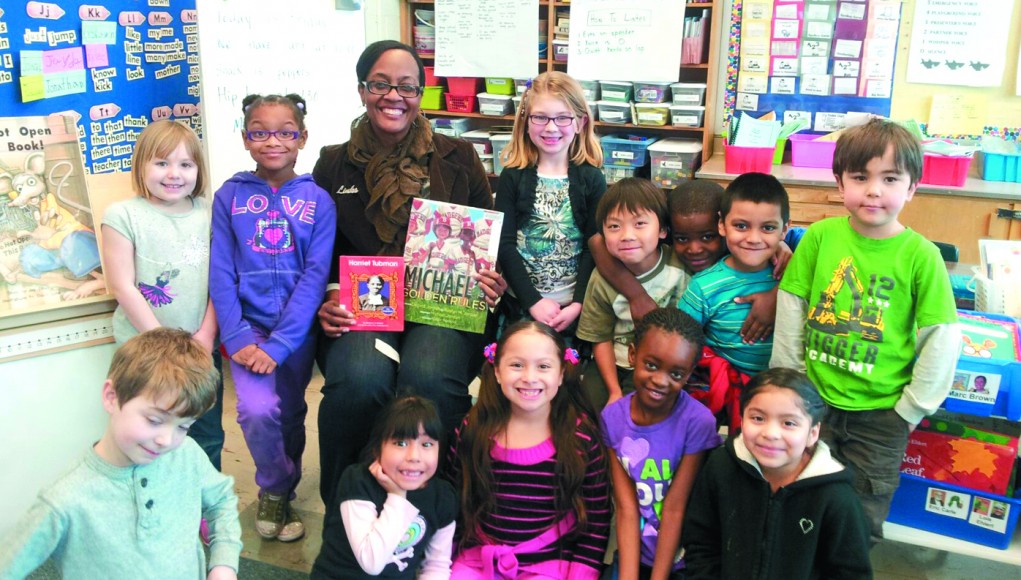Since they first began to study academic achievement, one consistent finding has always been that parental involvement is a huge key to a child’s academic success. For 12 years, “Read Your Heart Out Day” has brought parents, family members and community members into the schools to read to elementary school classes to encourage and to continue to support parent involvement in the schools.
Michelle Belnavis founded “Read Your Heart Out Day” back in 2004. The idea was to recruit African American family members and community members as readers to read to young people to build positive family, community and school relationships.
“Back then, we were in just five schools and we were celebrating what was called ‘100 Days of School with The 100 Black Men of Madison,’” Belnavis tells Madison365.
The event slowly added schools over the years as they planned it to coincide with National African American Parent Involvement Day (NAAPID). Ann Arbor, Mich., Public Schools Principal Joseph Dulin conceived the idea of a NAAPID after accepting the challenge given at the Million Man March to return home and do more to build, involve, and increase their commitment to improving the quality of life in their community, particularly for African Americans.
As “Read Your Heart Out Day” added more schools, they began to add more community readers. “Pastors joined The 100 Black Men and we had community representation from sororities and fraternities and high school students and athletes,” Belnavis remembers. “We just grew and grew and embraced the UW sports – some of our UW basketball players and football players came to join in. More and more people participated. Now, we’re at 21 schools!”
The event now includes two schools in Beloit and one in Sun Prairie. This year’s event will be the first time that the event has expanded throughout the month. Instead of just one day, “Read Your Heart Out Day will be held on Feb. 4th, 10th and 26th.

As the technical assistance coordinator for cultural responsiveness for the State of Wisconsin Response to Intervention Center, Belnavis helps teachers, schools and districts with how to think about how to make their instruction and curriculum more culturally responsive to the students and families they serve.
“’Read Your Heart Out Day’ is the perfect door to continue to open and increase engagement statewide,” Belnavis says.
The intention of “Read Your Heart Out” Day is to build positive family, community, and school relationships. This national observation provides a vehicle to open up dialogue among teachers, parents, and students that will lead to a more conducive learning environment for every student, from kindergarten through college. Parents are encouraged to participate and they very often do.
“We do surveys every year to really gather data about how ‘Read Your Heart Out Day’ changes behaviors and one of our biggest findings is that students who have traditionally struggled or have behavior concerns have seen in-time class increase and office referrals decrease specifically on this day,” Belnavis says. “We find that students are more actively engaged and want to be part of the learning and see themselves visible throughout the school. It encourages them to really change the way that they initially behave. We see another side of the child that was never visible before. A lot of times our students of color feel invisible and they feel the only way to be recognized or noticed is by acting out. So, this is an opportunity to flip that script and think about different ways to engage students so they feel different; so they feel like they belong. And they really want to show that inside pride that might have been shut down before.”
The MMSD Family, Youth and Community Engagement Department has been supporting the effort and helping to bring the schools together. As organizer and founder of the event, Belnavis makes sure that she is communicating a common message through the schools so the “Read Your Heart Out Day” brand stays strong. Belnavis hopes to build up the comfort level for African-American parents to become more involved in their children’s school. The event helps to establish a foundation for teachers and parents to help their children succeed academically.

Can I participate even if I’m not African American?
“Of course! The celebration of National African American Parent Involvement Day is an opportunity to engage all families in learning about different cultural learning styles,” Belnavis says. “But it is also to really celebrate and have our African-American representation increased so that parents and families who might not normally be involved in school will be wanting to come back because they feel a sense of belonging and are feeling recognized.”
Belnavis says that, in the end, it’s all about building community and building partnerships. “We are doing work to create community partnerships with 100 Black Men, with newspapers, with fraternities and sororities and much more to celebrate youth student achievement,” Belnavis says. “Students will be performing at the event and when students perform, our families become more engaged and there is a sense of prioritizing. It’s all about students feeling like they really matter.
“Too often, our students of color don’t feel like that because, really, how our schools are set up …they don’t always embrace all of the students and we’re just trying to fill that gap,” she adds.
Belnavis has seen her “Read Your Heart Out Day” grow quite a bit in just 12 years. She still feels like it still has a lot of room to grow.
“We’ve seen that it has been successful and I really have enjoyed watching it grow. For these kids, having your family there and performing and really bringing out the inner-child is what this day does. In the end, connecting your child really is what contributes to academic and behavioral outcomes,” she says. “When you have behaviors that are really positive, then the real academic learning can take place.”




























